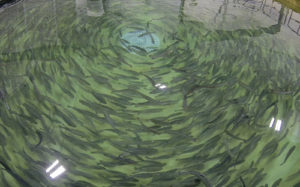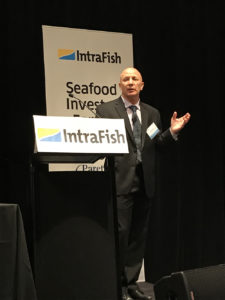At the IntraFish Seafood Investor Forum, a trend emerges for larger smolts released to net pens, and more time in RAS

Recirculating aquaculture systems based on land, a progressive and costly environmental risk-mitigation tool, was the talk of the town at the IntraFish Seafood Investor Forum held last week at New York City’s posh W Hotel. The technology, which the world’s leading ocean net pen producers of salmon once scoffed at for its high capital and energy requirements, now has a crowded bandwagon – of salmon producers.
Recirculating aquaculture systems (RAS) built on land are gaining in popularity, with a slew of modern indoor facilities popping up recently in Poland, Denmark, Iceland, China, Canada and the United States. While still yet to fully prove a robust, long-term economic viability, RAS has at least proven to be essential for the early stages (hatcheries, nurseries) of a fish’s life cycle.
And the growing RAS trend in salmon appears to be keeping the kids in day care a bit longer. Salmon farmers are now seeing the benefits of releasing larger fish to the grow-out stages in ocean net pens, while maximizing the protective benefits of RAS. With the soaring costs of antibiotics and sea lice remedies cutting into an extremely profitable industry, reducing biological risk is a wise cost-savings measure.
“Big smolts are good business for the farmer,” said opening keynote speaker Henning Lund, senior analyst for Pareto Securities, which co-hosted the event. “Shorter time in the sea is a powerful cost element.”
Across Norway, salmon producers are stocking fish in net pens at sizes of 100 to 150 grams, said Lund, who then predicted that all producers will be stocking 500-gram fish in the water in just a few years.
It’s a strategy already being adopted by Bakkafrost, the Faroe Islands’ largest salmon farming company. Bakkafrost will release 11.5 million smolts into its net pen operations in 2017, but now at 500 grams each. Gunnar Nielsen, corporate finance advisor and auditor, said at the conference that the move was made to reduce biological risk.

Despite years of skepticism, Lund emphasized that the financial returns are there for land-based aquaculture, a sentiment shared by Yoav Dagan, VP and co-owner of AquaMaof Aquaculture Technologies, which was recently hired by Grieg NL to build what the companies claim will be the world’s largest indoor salmon aquaculture facility in Newfoundland, Canada.
But RAS, as it applies to other species to be grown to market size fully indoors, is not for everybody, he warned. Any new projects should have a minimum production capacity of 5,000 metric tons to leverage economies of scale.
“It’s an opportunity for serious investors. It’s no longer a farmer game,” said Dagan, who rattled off a budding global portfolio of facilities established in Poland, Israel (where AquaMaof is based), Russia, Slovakia, Brazil and elsewhere.
Plate-sized fish (1 to 2 pounds each) are the perfect fit for RAS, but the technology is key for salmon for two simple facts: one, growth can be controlled; and two, it’s not necessary to transport live fingerlings that are potentially infected with a Vibrio bacteria, as is often the case with sea bream and sea bass.
“The beauty of salmon is you take the eggs, and have the full cycle under one project,” said Dagan. “Salmon has great potential to close the loop, to be independent and keep bio-security.”
Claiming expertise in 20 species – marine, freshwater and ornamental fish species – Dagan called the RAS business “rewarding” but one that faces unique challenges. For instance, fish growing in tanks will release hormones that can accelerate maturation, and may ultimately cause an off flavor in fillets. The AquaMaof system prevents this, he said. Using no mechanical filters, the company’s technology is simple to manage, he said, requiring low energy and little maintenance.
We’re still trying to explain the industry to larger investors. Some expectations are way out there.
“We are not smarter than anyone else,” said Dagan, referring to RAS technologies from the Netherlands, Germany, Canada and the United States. “But all of them are from a wastewater philosophy. We come from a philosophy of fish production.”
Joe McElwee, global sales manager for Pentair Aquatic Eco-Systems, agreed that RAS is attracting the interest of the salmon industry’s largest companies, and what is in play today is merely the tip of the sword.
“It’s a young industry. We’re still learning on the sea side technology,” he said. “Land-based aquaculture was a supplier to ocean-based. But nowadays, it’s the big commercial entities looking at this as a global business. And there’s a huge technological learning curve. There’s no one model that’s working for anybody yet.”
Educating investors about the technology, and urging patience on their parts, is still a challenge, said McElwee.
“We’re still trying to explain the industry to larger investors. Some expectations are way out there,” he added. “They read off the litany of disasters, rather than the litany of successes.”
AKVA Group, which developed steel cages for the Chilean salmon farming industry back in the 1980s, develops both ocean-cage and land-based aquaculture systems today. Hallvard Muri, CEO, said the land-based technology segment of his business represented 20 percent of the company’s 2016 revenue. He added that his salmon clients are looking to produce larger smolts to reduce their at-sea production cycles. For this reason alone, the prospects for RAS are solid.
“Growth is in the land-based tech segment,” Muri said, pointing to big opportunities for the company in the Mediterranean – namely Turkey and Greece – and in Iran. “Developing industrial scale farming is a top government priority.”
Dagan, of AquaMaof, said even the desert climate is no deterrent for RAS. “Land-based aquaculture should be near the markets,” he said. “You don’t need to be near the water, just access to water and energy.”
Author
-

James Wright
Editorial Manager
Global Aquaculture Alliance
Portsmouth, NH, USA
Tagged With
Related Posts

Innovation & Investment
Aquaculture Exchange: George S. Lockwood
With his book, “Aquaculture: Will it Rise to Its Potential to Feed the World?” hot off the presses, the pioneer abalone farmer vents on U.S. aquaculture regulations but remains deeply optimistic about fish farming.

Innovation & Investment
Investors see (mostly) upsides in aquaculture’s outlook
Aquaculture is attractive to investors, but they remain wary of diseases that could stunt projections of massive growth. At the IntraFish Seafood Investors Forum in New York, discussion about the salmon industry and its challenges — antibiotics, genetically modified fish, Chile’s woes, sea lice — revealed both criticism and optimism.

Intelligence
A motive, and a market, for farmed fish in Mexico
Boasting ample areas for aquaculture and a robust domestic demand for seafood – not to mention its close proximity to the U.S. market – a land of opportunity lies in Mexico. Fish farming is primed to meet its potential south of the border.

Intelligence
An inside look at Sino Agro Foods’ giant prawn MegaFarm
Sino Agro Foods has developed a proprietary recirculating aquaculture system that yields high production volumes and profitability. The facility should significantly contribute to seafood production in China and to help satisfy increasing demand for high value, safe and sustainably produced seafood.

